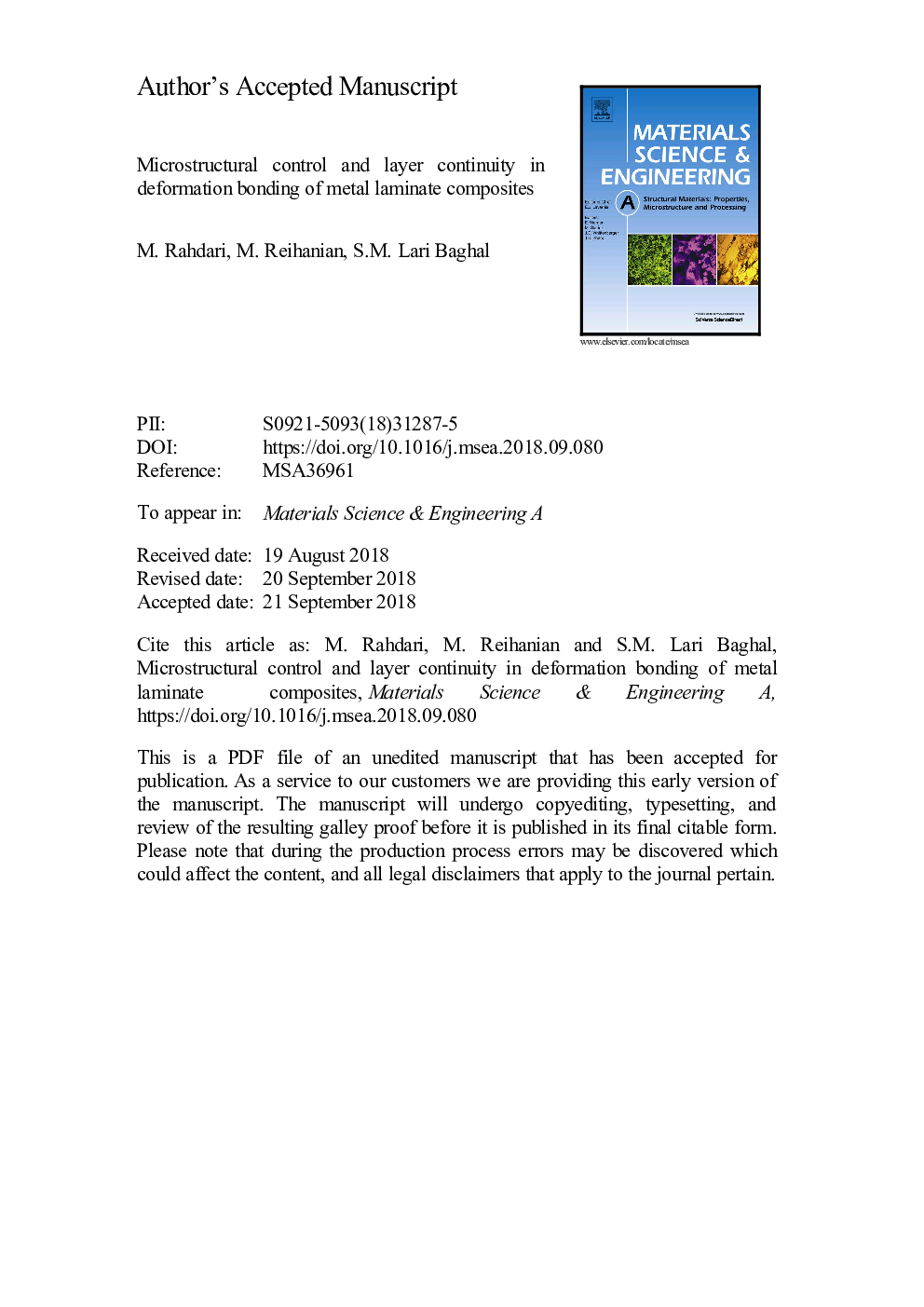| کد مقاله | کد نشریه | سال انتشار | مقاله انگلیسی | نسخه تمام متن |
|---|---|---|---|---|
| 11001637 | 1001561 | 2018 | 49 صفحه PDF | دانلود رایگان |
عنوان انگلیسی مقاله ISI
Microstructural control and layer continuity in deformation bonding of metallic laminated composites
ترجمه فارسی عنوان
کنترل میکرو سازه و پیوستگی لایه در ترکیب بندی تغییر شکل از کامپوزیت های ورقه ای فلزی
دانلود مقاله + سفارش ترجمه
دانلود مقاله ISI انگلیسی
رایگان برای ایرانیان
کلمات کلیدی
کامپوزیت لمینیت، پیوند رول، ریز ساختار، رفتار کششی، جداسازی فشار شبیه سازی،
ترجمه چکیده
یک مطالعه تجربی و شبیه سازی برای بررسی ریزساختار و رفتار کششی کامپوزیت های لمینیت فلزی رول با ترکیب یک لایه سخت تکمیل شده است. برای کنترل ریزساختار، اثر ضخامت لاک سخت، مواد سخت لایه و دنباله لایه در تداوم لایه در مدت زمان پارتیشن بندی کرنش، درجه خم شدن و عامل تقویت کرنش مورد بررسی قرار گرفته است. یافته شده است که در رژیم های کم فشار، کاهش ضخامت لایه های مختلف تقریبا یکسان است و کرنش به طور مساوی بین لایه ها تقسیم می شود. در رژیم های فشار بالا، بسته به ضخامت و سختی، گردن های ناپایدار و پارگی در لایه سخت رخ می دهد که منجر به پراکندگی محدوده بین لایه های تشکیل دهنده می شود و موجب تغییر شکل غیر هومیوژن می شود. به طور کلی، پارتیشن بندی فشار، درجه گرد و غبار و عامل تقویت کرم با کاهش نسبت ضخامت و افزایش نسبت سختی افزایش می یابد. نتایج نشان می دهد که این پارامترها با تغییر لایه دنباله دار تحت تاثیر قرار می گیرند. نتایج آزمون کشش نشان می دهد که استحکام کششی ساختار شکست خورده بالاتر از ساختار لایه ای یا پیوسته است. در تمام موارد، نتایج تجربی و شبیه سازی در توافق خوب است.
موضوعات مرتبط
مهندسی و علوم پایه
مهندسی مواد
دانش مواد (عمومی)
چکیده انگلیسی
An experimental and simulation study is carried out to investigate the microstructure and tensile behavior of the roll-bonded metallic laminated composites incorporating a single hard layer. To control the microstructure, the effect of the hard layer thickness, hard layer material and layer sequence on the layer continuity is investigated in term of the strain partitioning, degree of necking and strain amplification factor. It is found that at low strain regimes, the thickness reduction of different layers is almost identical and the strain is partitioned equally between the layers. At high strain regimes, depending on the thickness and hardness ratio, unstable necks and rupture occur in the hard layer that lead to the strain partitioning between the constituent layers and cause the deformation to be inhomogeneous. Generally, the strain partitioning, degree of necking and strain amplification factor increase with decreasing the thickness ratio and increasing the hardness ratio. Results show that these parameters are affected by changing the layer sequence. Tensile test results reveal that the tensile strength of the fragmented structure is higher than that of the layered or continuous structure. In all cases, the experimental and simulation results are in a good agreement.
ناشر
Database: Elsevier - ScienceDirect (ساینس دایرکت)
Journal: Materials Science and Engineering: A - Volume 738, 19 December 2018, Pages 98-110
Journal: Materials Science and Engineering: A - Volume 738, 19 December 2018, Pages 98-110
نویسندگان
M. Rahdari, M. Reihanian, S.M. Lari Baghal,
